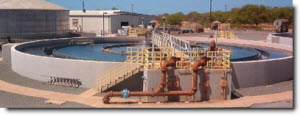Sources and Solutions: Wastewater
Wastewater Treatment Plants
Most homes and businesses send their wastewater to a treatment plant where many pollutants are removed from the water. Wastewater treatment facilities in the United States process approximately 34 billion gallons of wastewater every day. Wastewater contains nitrogen and phosphorus from human waste, food and certain soaps and detergents. Once the water is cleaned to standards set and monitored by state and federal officials, it is typically released into a local water body, where it can become a source of nitrogen and phosphorus pollution.

Some wastewater treatment plants are able to remove more nitrogen and phosphorus from their discharges than others depending on their equipment and how they treat wastewater. Enhanced treatment systems enable some wastewater plants to produce discharges that contain less nitrogen than plants using conventional treatment methods. Upgrading wastewater treatment systems is often expensive for municipalities and rate payers, but upgrades can pay for themselves or end up saving a plant money. Other treatment plants are able to adjust operations and repurpose existing equipment to remove additional nutrients. This approach, often referred to as optimization, is usually much less expensive than upgrades, and for many plants can result in cost savings by reducing energy demand and treatment chemicals. In some cases, optimization along with further technology upgrades may be necessary to achieve the nutrient reduction goals of the plant. Various strategies to reduce nitrogen and phosphorus loads from wastewater treatments plants are being pursued across the country.
More detailed information on nutrient removal technology and costs:
- Fact Sheets Related to the National Study of Nutrient Removal and Secondary Technologies
- Reports on Nutrient Pollution Control
Septic Systems

Approximately 20 percent of homes in the United States use septic systems that locally treat their wastewater. When a septic system is improperly managed, elevated nitrogen and phosphorus levels can be released into local water bodies or ground water. An estimated 10 to 20 percent of septic systems fail at some point in their operational lifetimes. Common causes of septic system failure include aging infrastructure, inappropriate design, overloading with too much wastewater in too short a period of time and poor maintenance.
Homeowners are responsible for maintaining their septic systems in most cases. To protect and maintain their system, homeowners should:
- Have their system inspected regularly and pump their tank as necessary
- Use water efficiently
- Not dispose of household hazardous waste in sinks or toilets
- Avoid driving vehicles or placing heavy objects on their drainfield
- Visit the EPA's decentralized wastewater (septic) systems webpage to learn more about septic systems and the EPA's SepticSmart Week Program
- Consult the EPA's guide on maintaining septic systems for more information: Homeowner's Guide to Septic Systems
